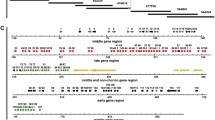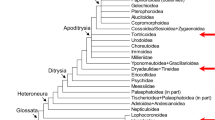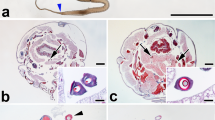Summary
The main features of the B family of chorion proteins in saturniid moths were examined by partial sequencing of representative B proteins, seven fromAntheraea polyphemus and two fromA. pernyi. Comparisons were made to sequences derived from seven recombinant DNA clones representing three types of B family proteins ofA. polyphemus. The central regions of the sequences are conservative, both within and between moth species, and differ largely by a few amino acid replacements, rather than deletions or insertions. By contrast, the amino-terminal third varies more substantially, in a manner which defines two protein subfamilies: within each subfamily sequences are similar, but the subfamilies differ by at least two multiresidue deletions as well as by amino acid replacements. These properties are analogous to features of the A family of chorion proteins.
Similar content being viewed by others
References
Doolittle RF (1977) Sequencing peptides and proteins lacking free amino groups. In: Needleman SB (ed) Advanced methods in protein sequence determination. Springer, New York, pp 38–54
Efstratiadis A, Kafatos FC (1976) The chorion of insects: Techniques and perspectives. In: Last JA (ed) Eukaryotes at the subcellular level. Methods in molecular biology, vol. 8. Marcel Dekker, New York, pp 1–124
Gross E (1967) The Cyanogen Bromide Reaction. In: Hirs CHW (ed) Methods in enzymology, Vol. XI. Academic Press, New York, pp 238–255
Hamodrakas SJ, Jones CW, Kafatos FC (1982) Secondary structure predictions for silkmoth chorion proteins. Biochim Biophys Acta 700:42–51
Jones CW, Kafatos FC (1980a) Coordinately expressed members of two chorion multigene families are clustered, alternating, and divergently oriented. Nature 284:635–638
Jones CW, Kafatos FC (1980b) Structure, organization and evolution of developmentally-regulated chorion genes in a silkmoth. Cell 22:855–867
Jones CW, Kafatos FC (1982) Accepted mutations in a gene family: Evolutiony diversification of duplicated DNA. Mol Evol 19:87–103
Jones CW, Rosenthal N, Rodakis GC, Kafatos FC (1979) Evolution of two major chorion multigene families as inferred from cloned cDNA and protein sequences. Cell 18:1317–1332
Kafatos FC, Regier JC, Mazur GD, Nadel MR, Blau HM, Petri WH, Wyman AR, Gelinas RE, Moore PB, Paul M, Efstratiadis A, Vournakis JN, Goldsmith MR, Hunsley JR, Baker B, Nardi J, Koehler M (1977) The eggshell of insects: Differentiationspecific proteins and the control of their synthesis and accumulation during development. In: Beermann W (ed) Results and problems in cell differentiation, Vol. 8. Springer, Berlin Heidelberg New York, pp 45–145
Moschonas N (1980) Evolutionary comparisons of chorion structural and regulatory genes in two wild silkworm species. PhD Thesis, University of Athens, Athens, Greece
Paul M, Goldsmith MR, Hunsley JR, Kafatos FC (1972) Specific protein synthesis in cellular differentiation: Production of eggshell proteins by silkmoth follicular cells. J Cell Biol 55:653–680
Podell DN, Abraham GN (1978) A technique for the removal of pyroglutamic acid from the amino terminus of proteins using calf liver pyrogluatmate amino peptidase. Biochem Biophys Res Commun 81:176–185
Regier JC, Kafatos FC (1981) In vivo kinetics of pyrrolidonecarboxylic acid formation in selected silkmoth chorion proteins. J Biol Chem 254:6444–6451
Regier JC, Kafatos FC, Goodfliesh R, Hood L (1978a) Silkmoth chorion proteins: Sequence analysis of the products of a multigene family. Proc Natl Acad Sci USA 75:390–394
Regier JC, Kafatos FC, Kramer KJ, Heinrikson RL, Keim PS (1978b) Silkmoth chorion proteins: Their diversity, amino acid composition, and the amino terminal sequence of one component. J Biol Chem 253:1305–1314
Regier JC, Mazur GD, Kafatos FC (1980) The silkmoth chorion: Morphological and biochemical characterization of four surface regions. Dev Biol 76:286–304
Regier JC, Kafatos FC, Hamodrakas SJ (1983) Silkmoth chorion multigene families constitute a superfamily: Comparison of C and B family sequences. Proc Natl Acad Sci USA 80: 1043–1047
Rodakis GC (1978) The chorion of the leipdopteranAntheraea polyphemus: A model system for the study of molecular evolution. PhD Thesis, University of Athens, Athens, Greece
Rodakis GC, Kafatos FC (1982) The origin of evolutionary novelty in proteins: How a high-cysteine chorion protein has evolved. Proc Natl Acad Sci USA 79:3551–3555
Rodakis GC, Moschonas NK, Kafatos FC (1982) Evolution of a multigene family of chorion proteins in silkmoths. Mol Cell Biol 2:554–563
Sim GK, Kafatos FC, Jones CW, Koehler MD, Efstratiadis A, Maniatis T (1979) Use of a cDNA library for studies on evolution and developmental expression of the chorion multigene families. Cell 18:1303–1316
Spande TF, Witkof B, Decani Y, Patcornic A (1970) Selective cleavage and modifications of peptides and proteins. Adv Prot Chem 24:97–260
Swank RT, Munkres KD (1971) Molecular weight analysis of oligopeptides by electrophoresis in polyacrylamide gel with sodium dodecyl sulfate. Anal Biochem 39:462–477
Terhorst C, Parham P, Mann DL, Strominger JL (1976) Structure of HLA antigens: Amino-acid and carbohydrate compositions and NH2-terminal sequences of four antigen preparations. Proc Natl Acad Sci USA 73:910–914
Tsitilou SG, Regier JC, Kafatos FC (1980) Selection and sequence analysis of a cDNA clone encoding a known chorion protein of the A family. Nucl Acids Res 8:1987–1997
Witkop B (1968) Chemical cleavage of proteins. Science 162: 318–326
Author information
Authors and Affiliations
Rights and permissions
About this article
Cite this article
Rodakis, G.C., Moschonas, N.K., Regier, J.C. et al. The B multigene family of chorion proteins in saturniid silkmoths. J Mol Evol 19, 322–332 (1983). https://doi.org/10.1007/BF02101635
Received:
Issue Date:
DOI: https://doi.org/10.1007/BF02101635




